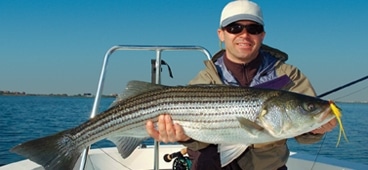
Feb 06-Resoruse-Striper-McMurray
To saltwater fly-rodders in the Northeast striped bass are undoubtedly the most important quarry. That’s why many of us raised our eyebrows back in the fall of 2004 when the Atlantic States Marine Fisheries Commission released its 2003 striped bass stock assessment.
The virtual population analysis (VPA) model the ASMFC had used to gauge the health of the stock revealed that larger, older striped bass (ages seven to 11 or fish in the 10-plus-pound range) were being frighteningly overfished. According to the report, the kill rate for such older fish was 150 percent above the overfishing threshold (the point at which the commission requires corrective action be taken). The numbers further indicated that the largest, oldest fish – those we would label “trophies” – suffered the highest mortality. The report also suggested that spawning-stock biomass had been spiraling downward for several years before 2003.
Although unsettling to all of us in the saltwater fly-fishing community, it was hardly a surprise. A trip to any local marina in the spring or fall of 2003 and 2004 provided ample, albeit anecdotal, evidence that these bigger fish were taking a beating. Factor in a banner two years for the illegal striped bass “poaching” industry and it’s easy to see
the problem.
The estimated increase in mortality and decrease in spawning fish contained in the 2003 assessment was so dramatic that members of the ASMFC technical committee questioned the accuracy of its findings. Conversely, tagging data, which was previously considered less reliable than the population model, indicated that the kill rate was just a hair over target and under the overfishing threshold.
While many anglers would have preferred the commission take precautionary measures back then, the board decided to wait another year to see if the 2004 stock assessment confirmed the overfishing of older, larger bass. New York was given permission at the meeting to increase its bag limit from one fish to two, which it subsequently did.
Because the 2004 ASMFC report reflected the 2003 catch data, the numbers didn’t account for changes that occurred after amendment six to the striped bass management plan was adopted. Regulations became more liberal, for example, the commercial quota was increased by 40 percent, and Massachusetts – the largest recreational harvester on the coast – decided to increase anglers’ bag limits from one fish to two.
Many folks in the angling community were fairly certain that the number of larger, older bass killed in 2004 would be greater than in 2003, forcing the ASMFC to take action and quell what appeared to many to be an unsustainable harvest.
But that’s not quite what happened. Enter the 2004 Striped Bass Stock Assessment. On October 31, 2005, the assessment was released at the ASMFC Striped Bass Management Board meeting in New Jersey. A new formula dramatically changed the estimates in fishing mortality for both 2003 and 2004. Under the old VPA model, 2004 fishing mortality would have far exceeded the threshold for corrective action – as many expected.
This massaging of numbers caused the mortality and population estimates for both years to change in a way that cast the ASMFC’s management of the species in a much more favorable light. According to Gary Shepard at NOAA’s NE Fisheries Science Center, a workshop in April re-examined all the indices (items of statistical input) used in the assessments to determine if each was statistically valid.
Despite serious doubts, the ASMFC didn’t miss a chance to pat itself on the back, claiming in a press release that “scientific advice presented to the commission’s Atlantic Striped Bass Management Board indicates that striped bass management under amendment six to the interstate management plan continues to be a success.” However, even with the very significant changes in the stock assessment due to the adoption of the revised model, anglers are still on the brink of overfishing those seven-plus-year-old striped bass, and about 30 percent above the target fishing mortality established in amendment six. In addition, the 2004 stock assessment pointed out that the number of fish killed was up 33 percent from numbers in 2003. However, because the mortality level is still below the threshold, the commission is not required to take any action and so presumably will maintain the status quo.

President Brad Burns attended the ASMFC Striped Bass Management Committee meeting. He reports that Rhode Island’s Mark Gibson, once chair of the ASMFC striped bass scientific committee, expressed concern that the current harvest of mature fish is too close to the overfishing threshold to provide a reasonable margin for error. New York ASMFC Commissioner Gordon Colvin added he was not convinced that the management board shouldn’t be talking about serious conservative changes to striped bass management.
Many in the angling community suspect that the change in the VPA model was the result of pressure the commission felt to protect its image and the accuracy of the management plans it had created in the past. Regardless, given that the new stock assessment’s numbers still indicate we are so close to overfishing larger, older fish, and given the well-known fact that there is a lot of variability in any terminal-year estimate derived from the VPA, one would hope that the ASMFC would prefer to err on the side of conservation.
Currently, I’m hearing from fly-rodders from North Carolina to Maine who report that the number of large fish taken in 2005 is much lower than in previous years. While those who fish with bait or plugs may disagree, fly-rodders are the proverbial canaries in the coal mine. The technique we use makes it harder to catch large fish, and we are the first to see the effects of a decline.
According to Burns, Stripers Forever’s annual survey is still in progress. But with several hundred surveys in from Maine through New York, about two out of three anglers report a negative trend in both the size and quantity of striped bass during the 2005 season.









